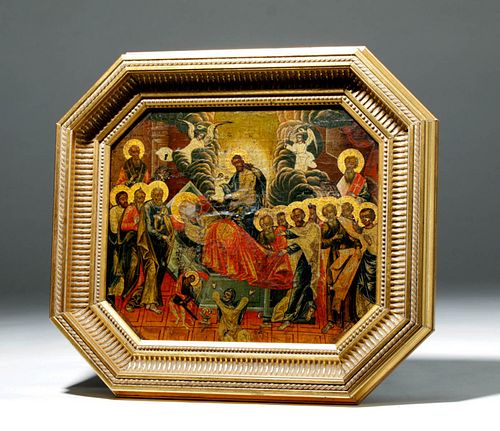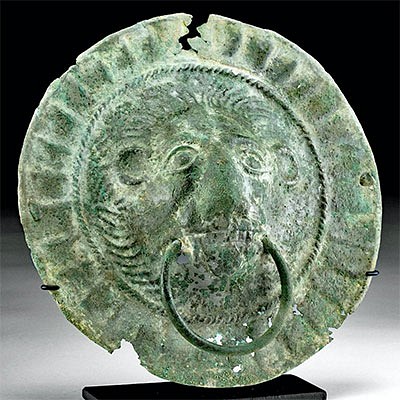19th C. Russian Icon - Dormition, Holy Theotokos
Lot 285a
About Seller
Artemis Fine Arts
686 S Taylor Ave, Ste 106
Louisville, CO 80027
United States
Selling antiquities, ancient and ethnographic art online since 1993, Artemis Gallery specializes in Classical Antiquities (Egyptian, Greek, Roman, Near Eastern), Asian, Pre-Columbian, African / Tribal / Oceanographic art. Our extensive inventory includes pottery, stone, metal, wood, glass and textil...Read more
Categories
Estimate:
$1,600 - $2,400
Absentee vs Live bid
Two ways to bid:
- Leave a max absentee bid and the platform will bid on your behalf up to your maximum bid during the live auction.
- Bid live during the auction and your bids will be submitted real-time to the auctioneer.
Bid Increments
| Price | Bid Increment |
|---|---|
| $0 | $25 |
| $300 | $50 |
| $1,000 | $100 |
| $2,000 | $250 |
| $5,000 | $500 |
| $10,000 | $1,000 |
| $20,000 | $2,500 |
| $50,000 | $5,000 |
| $100,000 | $10,000 |
| $200,000 | $20,000 |
About Auction
By Artemis Fine Arts
Oct 14, 2021
Set Reminder
2021-10-14 10:00:00
2021-10-14 10:00:00
America/New_York
Bidsquare
Bidsquare : CLEARANCE | Ancient & Ethnographic Art
https://www.bidsquare.com/auctions/artemis-gallery/clearance-ancient-ethnographic-art-7705
Kick off fall with our clearance sale featuring discounted pricing and many new items! Asian art, Classical antiquities from Egypt, Greece, Italy, and the Near East...plus Pre-Columbian, Tribal, Russian Icons & Enamelware, Spanish Colonial, Fine Art, Fossils, more! Starting prices have been reduced Artemis Fine Arts info@artemisfinearts.com
Kick off fall with our clearance sale featuring discounted pricing and many new items! Asian art, Classical antiquities from Egypt, Greece, Italy, and the Near East...plus Pre-Columbian, Tribal, Russian Icons & Enamelware, Spanish Colonial, Fine Art, Fossils, more! Starting prices have been reduced Artemis Fine Arts info@artemisfinearts.com
- Lot Description
**Originally Listed At $2500**
Eastern Europe, Russia, ca. 19th century CE. A touching rendition of the Dormition of the Virgin showing the Holy Theotokos on her deathbed surrounded by mourning Apostles, Church Fathers, and pious women in egg tempera and gold leaf on wood and housed in a custom octagonal wooden frame finished with gold leaf. Christ has descended from heaven surrounded by angels, looking at his mother as he holds a small swaddled child who represents the soul of the Virgin Mary. In front of her deathbed, the Archangel Gabriel raises his sword to cut off the hands of the impious priest who wishes to upend the bier. So skillfully painted with naturalistic visages and hands, beautifully delineated drapery folds and billowing clouds, as well as Byzantine inspired pantomime gestures and liberal use of gold leaf. The flooring demonstrates the artist's interest in linear perspective, and the composition is impressively complex. Size: 15" W x 17" H (38.1 cm x 43.2 cm)
Donning garments of jewel tone blue and golden highlights that radiate hallowed golden rays, Jesus is presented in divine glory. The apostles are depicted standing in two clusters before architectural interiors of columniated arches which most likely metaphorically represent Mary's house and the Temple of Jerusalem (the destination of the procession), the apostles depicted in Byzantine fashion with their dramatic postures and gestures directing our attention toward Mary. The Dormition of the Virgin is among the most important feast days of the Eastern Orthodox Church. Commemorating the Virgin’s death or “falling asleep” and her resurrection prior to being taken to heaven, it is celebrated on August 15th. This is a fine example of the icon of this feast.
The story behind this iconography is as follows. On one of the many occasions when the Virgin was praying at Golgotha, the Archangel Gabriel appeared to her and announced that her demise from this life to eternal life was fast approaching, and the Virgin prayed that the Lord would have the apostles come see her again and prepared for her deathbed. Then the apostles were carried miraculously from their locales of preaching to Jerusalem where they gathered together to mourn with Christ appearing behind the coffin carrying his mother’s soul. In the words of Theodore the Studite, “ You fell asleep, yes, but not to die. You were assumed into heaven, but you never cease to protect humanity.” (Alfredo Tradigo, “Icons and Saints of the Eastern Orthodox Church” The Getty Museum (2004) p. 153)
Icons (icon means "image" in Greek) are sacred objects within the Eastern Orthodox Christian tradition. Found in homes as well as churches, these painted images depict holy persons and saints as well as illustrate scenes from the Scriptures. Icons are not worshiped, but are instead venerated for their ability to focus the power of an individual's prayer to God. As such they are truly "windows into heaven."
Provenance: private Francis & Lilly Robicsek Collection, Charlotte, North Carolina, USA, acquired second half of the 20th century
All items legal to buy/sell under U.S. Statute covering cultural patrimony Code 2600, CHAPTER 14, and are guaranteed to be as described or your money back.
A Certificate of Authenticity will accompany all winning bids.
PLEASE NOTE: Due to recent increases of shipments being seized by Australian & German customs (even for items with pre-UNESCO provenance), we will no longer ship most antiquities and ancient Chinese art to Australia & Germany. For categories of items that are acceptable to ship to Australia or Germany, please contact us directly or work with your local customs brokerage firm.
Display stands not described as included/custom in the item description are for photography purposes only and will not be included with the item upon shipping.
#119486Nice craquelure to the surface, some raising to the region of the Virgin's arm and lower robes of Christ. Just a few small nicks to the frame (which dates later than the icon itself) near the junctures between sections. Verso still possesses a vertical back slat.Condition
- Shipping Info
-
All shipping is handled in-house for your convenience. Your invoice from Artemis Gallery will include shipping calculation instructions. If in doubt, please inquire BEFORE bidding for estimated shipping costs for individual items.
-
- Buyer's Premium



 EUR
EUR CAD
CAD AUD
AUD GBP
GBP MXN
MXN HKD
HKD CNY
CNY MYR
MYR SEK
SEK SGD
SGD CHF
CHF THB
THB




















